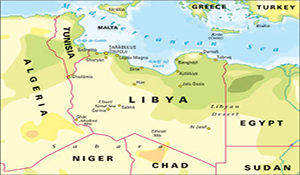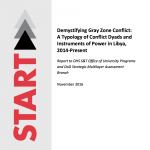Demystifying the Gray Zone: Libya, 2014‐Present

Demystifying Gray Zone Conflict: A Typology of Conflict Dyads and Instruments of Power in Libya, 2014‐Present.
Author | Editor: Gabriel, R. & Johns, M. (University of Maryland, START).
This case study is intended to highlight the dynamics of Gray Zone conflict in Libya since 2014. It places specific emphasis on the roles of non‐state actors within the conflict and how these actors utilize different levels of power to achieve their aims. With a focus on analyzing the dyadic relationships between various types of conflict actors, this research examines which types of dyads employ which instruments of power, as well as to what extent these activities fall within the Gray Zone of conflict as opposed to the more precisely delineated Black and White arenas. This research aims to assist practitioners and policy makers in determining how the types of actors involved in a conflict can influence which instruments of power deserve special consideration in that conflict. This investigation will also aid Special Operations Forces (SOF) in determining which types of belligerents may make effective partners depending on the type of adversary faced, and which instruments of power SOF should train and equip these partners to implement.
This research substantially bounds the scope of what needs to be considered by U.S. forces operating in these environments. Specifically, the analysis shows that aggregating by actor‐type is effective. Aggregating Libya’s myriad actors into four distinct groups, which include internationally recognized governing bodies, rival political factions (hereby referred to as “rival governments”), local religiously‐ affiliated violent non‐state actors (VSNAs) and transnational VSNAs (e.g. the Islamic State of Iraq and the Levant (ISIL)), allows practitioners to identify the most relevant instruments of power at play given the actor‐types engaged in the conflict. Moreover, this analysis reduces the number of instruments of power that must be thoroughly considered in each conflict dyad from seven to an average of 4.5. Of these 4.5, an average of just 2 instruments of power are especially salient.
Furthermore, this analysis demonstrates that Libya’s conflict is Gray. While Gray Zone dynamics also include White and Black activities, all four of the dyads involve Gray activities. This study finds that competition between the elected and/or internationally recognized governing bodies and rival governments primarily occur across the diplomatic, informational, military, economic, financial and legal instruments of power. The situation in Libya is such that competing political groups have all had periods of international recognition and legitimacy at certain times and not others. During periods where a government has international recognition and legitimacy, it tends to prioritize White Zone diplomatic engagement and legal activities. When rival political groups are not internationally recognized, they have employed Gray Zone diplomatic negotiations, information engagement and financial activity in addition to Black Zone military and economic action.
Religiously affiliated VSNAs (including ISIL and al‐Qaeda (AQ) affiliates) are also involved in the conflict. Notably, information engagement occurring within the Gray Zone is the most potent instrument of power used by such groups regardless of the adversary, followed by Black Zone military action. When competing against government aligned forces, these VSNAs have similarly engaged in Gray Zone financial activity. Local VSNAs have engaged in Gray Zone diplomatic negotiations with international actors. In its competition against government‐aligned forces, ISIL has employed Black Zone economic activities.
When evaluating responses to conflicts involving governments and rival governments, practitioners should devote significant attention to the use of diplomatic and legal instruments of power as they have proven to be especially consequential. When addressing dyads involving religiously‐affiliated VNSAs, practitioners should pay particular attention to the informational and military instruments of power, as these instruments of power influence the use of the other instruments.
While the approach adopted by this research entails myriad advantages, readers should be cautioned that Gray Zone conflicts are extremely complex. Practitioners ought to consider how an intervention against one type of conflict actor might affect other types of actors operating in the same space. This is necessary to avoid negative externalities, such as inadvertently strengthening other combatants. Moreover, commanders must realize that the successful use of certain tactics within one instrument of power (e.g. military), can have profound effects on the efficacy of their opponent’s use of other instruments (e.g. economic or informational). Finally this case provides numerous examples of government forces collaborating with various VSNAs. While Special Operations Forces are especially well positioned to do so, this requires extensive situational awareness at the micro‐level as the micro and macro conflict landscapes are mutually constitutive and are thus highly reactive to disturbances on all levels. Alliances are fleeting and the willingness to cooperate with Special Operations Forces varies both over space and time.

Comments